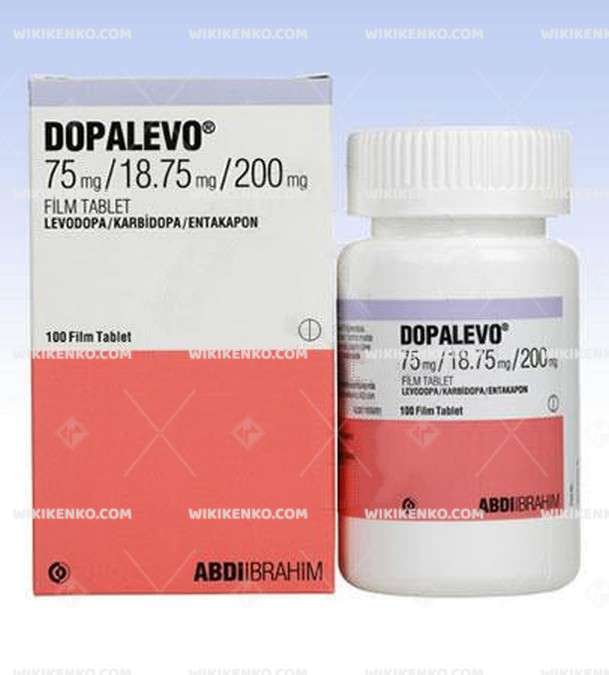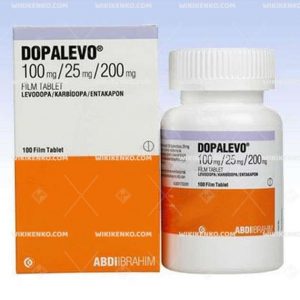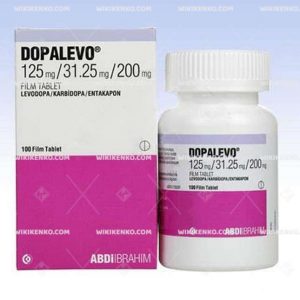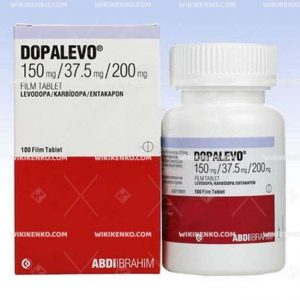Dopalevo Film Tablet 75/18.75/200 Mg
Dopalevo emerges as a crucial intervention in the therapeutic landscape of Parkinson’s disease. Combining three potent active ingredients—levodopa, carbidopa, and entacapone—this medication stands as a beacon of hope for patients grappling with the challenges posed by this neurodegenerative condition.
| Dosage form | |
|---|---|
| Pack size | |
| Potency | 75/18.75/200 Mg |
| Manufacturer | |
| Origin | |
| Generic Name (Ingredient) | Levodopa 75 Mg Carbidopa 18.75 Mg Entacapone 200 Mg |
Assuming your emergency circumstances for this product, visit Urgent Quotation page. Besides, for any pharmaceutical questions, please ask us in the comments section.
Description
Composition and Formulation
Each Dopalevo 75/18.75/200 mg film tablet encompasses a precise amalgamation of therapeutic agents, comprising 75 mg of levodopa, 18.75 mg of carbidopa, and 200 mg of entacapone. This meticulously crafted formulation underscores the synergy between its constituents, fostering optimal therapeutic outcomes.
Mechanism of Action
Levodopa, the cornerstone of Dopalevo, undergoes conversion into dopamine within the brain—a neurotransmitter pivotal in orchestrating motor function. Carbidopa complements this process by inhibiting the premature breakdown of levodopa in the periphery, ensuring its unimpeded access to the central nervous system. Concurrently, entacapone extends levodopa’s therapeutic window by impeding its peripheral metabolism, bolstering its bioavailability and efficacy.
Therapeutic Indications
Dopalevo assumes a pivotal role in alleviating the multifaceted symptomatology of Parkinson’s disease, encompassing muscle stiffness, tremors, spasms, and impaired motor coordination. By augmenting dopamine levels within the brain, it endeavors to assuage the debilitating manifestations of this progressive neurological disorder.
Side Effects and Precautions
The clinical spectrum of Dopalevo-associated adverse effects encompasses gastrointestinal disturbances, headache, dizziness, somnolence, visual disturbances, and musculoskeletal complaints. Prudent patient counseling mandates meticulous delineation of contraindications, including allergies, severe hepatic impairment, narrow-angle glaucoma, or pheochromocytoma.
Dopalevo Tablet Dosage
Adherence to prescribed dosage protocols is paramount to ensuring therapeutic efficacy and safety. it should be administered orally, typically 3 to 4 times daily, with each dose comprising a singular tablet. Emphasizing the importance of intact tablet ingestion, patients are advised against crushing, chewing, or splitting the formulation to forestall dosing inaccuracies and inadvertent staining.
Therapeutic Onset
The temporal trajectory of Dopalevo’s therapeutic onset is contingent upon multifarious variables, including metabolic dynamics, disease severity, and individualized responsiveness. Regular dosing consistency is advocated to sustain optimal dopamine levels, thereby fostering a salutary clinical milieu.
Considerations
While Dopalevo serves as a cornerstone in Parkinson’s disease management, its utilization in pediatric populations remains largely uncharted territory. Pregnant and lactating individuals necessitate judicious deliberation, with clinical decisions predicated upon meticulous risk-benefit analyses and comprehensive patient counseling.
Composition of Dopalevo Film Tablet 75/18.75/200 Mg
| Active Ingredient | Dosage (mg) |
|---|---|
| Levodopa | 75 |
| Carbidopa | 18.75 |
| Entacapone | 200 |
Conclusion
Dopalevo, epitomizing the symbiotic interplay between levodopa, carbidopa, and entacapone, delineates a transformative paradigm in Parkinson’s disease therapeutics. Empowered by a nuanced understanding of its mechanistic underpinnings and clinical ramifications, Dopalevo heralds a dawn of hope for patients navigating the labyrinthine complexities of Parkinson’s disease. Anchored by evidence-based practice and patient-centric care paradigms, it emerges as a beacon of respite in the arduous journey towards neurological well-being.
Use the form below to report an error
Please answer the questions as thoroughly and accurately as possible. Your answers will help us better understand what kind of mistakes happen, why and where they happen, and in the end the purpose is to build a better archive to guide researchers and professionals around the world.
The information on this page is not intended to be a substitute for professional medical advice, diagnosis, or treatment. always seek the advice for your physician or another qualified health provider with any questions you may have regarding a medical condition. Always remember to
- Ask your own doctor for medical advice.
- Names, brands, and dosage may differ between countries.
- When not feeling well, or experiencing side effects always contact your own doctor.
Cyberchondria
The truth is that when we’re sick, or worried about getting sick, the internet won’t help.
According to Wikipedia, cyberchondria is a mental disorder consisting in the desire to independently make a diagnosis based on the symptoms of diseases described on Internet sites.
Why you can't look for symptoms on the Internet
If diagnoses could be made simply from a textbook or an article on a website, we would all be doctors and treat ourselves. Nothing can replace the experience and knowledge of specially trained people. As in any field, in medicine there are unscrupulous specialists, differences of opinion, inaccurate diagnoses and incorrect test results.







Reviews
There are no reviews yet.